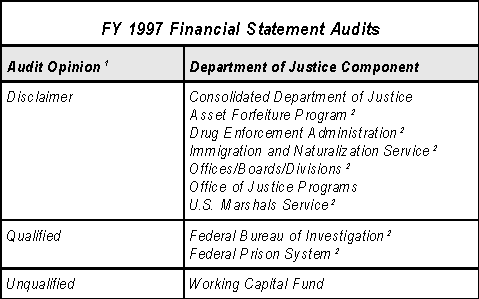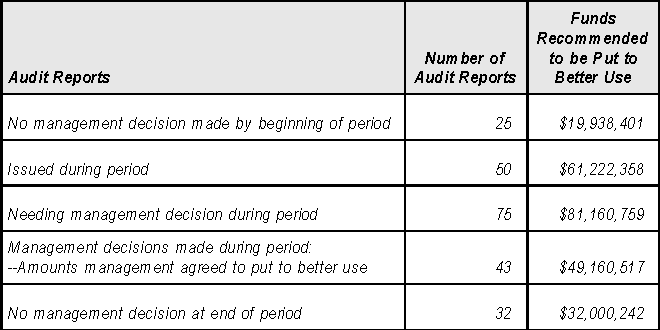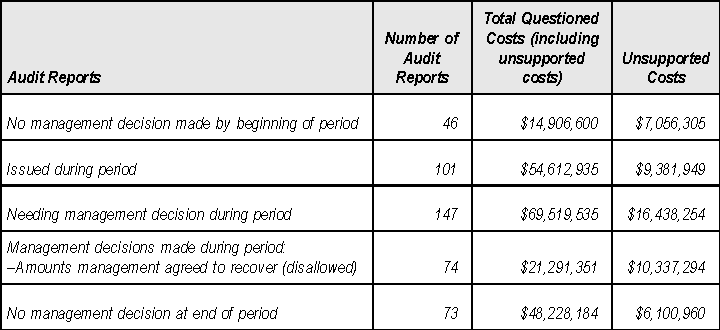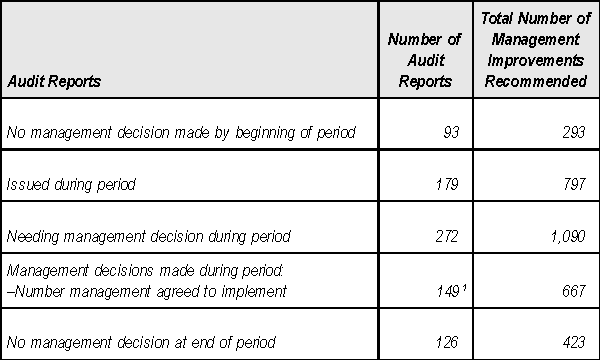
1 See glossary (p. A-23) for definitions of audit opinions.
2 Reports issued during this reporting period.
USDOJ/OIG - Semiannual Report to Congress, April 1, 1998 - September 30, 1998 |
Page 20 |
The Audit DivisionThe Audit Division is responsible for independent reviews of Department of Justice organizations, programs, functions, computer technology and security systems, and financial statement audits. |
USDOJ/OIG - Semiannual Report to Congress, April 1, 1998 - September 30, 1998 |
Page 21 |
Audit Division
The Audit Division (Audit) reviews Department of Justice (Department) organizations, programs, functions, computer technology and security systems, and financial statements. Audit also conducts or oversees external audits of expenditures made under Department contracts, grants, and other agreements. Audits are conducted in accordance with the Comptroller General's Government Auditing Standards and related professional auditing standards. Audit produces a wide variety of audit products designed to provide timely notification to Department management of issues needing attention. It also assists the Investigations Division in complex fraud cases.
Audit works closely with Department management to develop recommendations for corrective actions that will resolve identified weaknesses. By doing so, Audit remains responsive to its customers and promotes more efficient and effective Department operations. During the course of regularly scheduled work, Audit also lends fiscal and programmatic expertise to Department clients.
During this reporting period, Audit issued 17 internal reports of programs funded at over $835 million; 119 external reports of contracts, grants, and other agreements funded at over $293 million; 143 audits of bankruptcy trustees with responsibility for funds of over $307 million; and 134 Single Audit Act audits. Audit issued 5 Management Information Memoranda, 1 Technical Assistance Memorandum, 1 Investigative Assistance Memorandum, 6 Notifications of Irregularity, and 10 Management Letter Transmittals.
BOP's Management of New Prison Construction Contracts
Since the 1980s, a major Department concern has been the need to address ever increasing inmate populations. As stated in our audit, as of March 1997, Bureau of Prisons (BOP) facilities had an inmate capacity of 77,796. The federal inmate population is expected to be 122,607 by the year 2002. BOP has undertaken a large, complex construction program, having budgeted approximately $467 million for new prison construction during Fiscal Years (FYs) 1994, 1995, and 1996.
We noted improvements in BOP's management of construction contracts for new prisons since a similar 1991 audit, after which BOP had implemented detailed guidelines to improve construction project controls. However, improvement is still needed in construction planning and contract administration. We determined that BOP:
· incurred about $3 million in avoidable contract modification charges;
· could have saved from $7.1 million to $8.3 million in construction costs at one federal correctional site had it not compressed the construction schedule;
· did not follow established controls for ensuring timely and accurate contract payments and, as a result, made nearly $1.5 million in questionable payments and did not withhold funds for non-conforming work valued at $1.2 million; and
· did not evaluate potential architectural and engineering firm errors or omissions worth $6.6 million.
USDOJ/OIG - Semiannual Report to Congress, April 1, 1998 - September 30, 1998 |
Page 22 |
Significant Audit Products
Our recommendations addressed deficiencies in compliance with federal handicapped accessibility standards, cost analyses during initial prison design, development of construction schedules to avoid limited competition and excessive prices, review of draft and final payment requests, timeliness of contractor payments, and other aspects of contract administration.
Use of Department Funds by the Calumet Park, Illinois, Police Department
At the request of the Department's Criminal Division, we conducted an audit of funds awarded to the Calumet Park Police Department (CPPD) from the Department's Asset Forfeiture Fund. We also audited Office of Community Oriented Policing Services (COPS) and Office of Justice Programs (OJP) funds received by CPPD following allegations that Village of Calumet Park officials had used asset forfeiture funds for a trip to Disney World.
We determined that CPPD improperly spent asset forfeiture funds and did not have adequate controls over the use of federal funds. We questioned over half of the $151,674 in funds received by CPPD. We found that CPPD incurred $44,598 in unsupported or unallowable expenditures by Village officials and their families, including the mayor, chief of police, and assistant chief of police. We also questioned $37,500 in COPS funds because the CPPD supplanted local monies by not filling a vacant officer position in a timely manner.
Office of Community Oriented Policing Services
We continue to work with the COPS office in its implementation of the Violent Crime Control and Law Enforcement Act of 1994 (Crime Act). The Crime Act authorizes $8.8 billion over six years for grants to add 100,000 police officers to the nation's streets. During this reporting period, we performed 71 audits of COPS grants. Our audits identified over $30.6 million in questioned costs, over $56 million in funds that could be put to better use, and almost $19,000 in enhanced revenues. We initiate audits based on requests from the COPS office and OJP, allegations of misuse of grant funds, and selection by Audit. COPS findings to date may not necessarily be representative of the universe of grantees and in fact, may represent worst case scenarios. This is because, as a matter of policy, COPS has referred to us what it suspects might be its riskiest grantees. Our results to date, therefore, still may be skewed to problem grantees.
Our audits focus on (1) the allowability of grant expenditures, (2) the source of matching funds, (3) the implementation or enhancement of community policing activities, (4) efforts to fill vacant sworn officer positions, (5) plans to retain officer positions at grant completion, (6) grantee reporting, and (7) an analysis of supplanting issues. Results indicate that some jurisdictions are using federal funds to supplant local funds. Additionally, some jurisdictions may not be making sufficient effort to fill locally funded sworn officer positions, are not documenting efforts to redeploy officers to community policing, and may have difficulty retaining the officer positions with local funds at the conclusion of the grants.
USDOJ/OIG - Semiannual Report to Congress, April 1, 1998 - September 30, 1998 |
Page 23 |
Significant Audit Products
The following are examples of findings reported in our audits of COPS grants during this
period:
· The Atlanta, Georgia, Police Department received $13 million to hire 128 additional police officers and redeploy 144 officers into community policing. We determined that the Atlanta Police Department did not intend to retain all grant-funded positions upon grant completion, as required by the terms of the grant. In fact, the city passed a resolution to abolish 38 officer positions after federal funding ceased and to retain only 40 other officer positions if funds were available. We also found that the Atlanta Police Department did not make a good faith effort to perform community policing activities, supplanted local funds with grant funds, and charged unallowable costs to the grant. We questioned $3 million in reimbursed grant funds and recommended that $10 million in grant funds be put to better use.
· The Oxford, Michigan, Emergency Safety Authority received $595,000 to hire an additional 5 full-time and 6 part-time police officers and redeploy 2 officers into community policing. We determined that the Oxford Emergency Safety Authority supplanted local funds with grant funds, charged unallowable costs to the grants, did not enhance community policing by the number of officers funded by the grants, and failed to develop a plan to track the redeployment of the officers into community policing. We questioned $178,000 in reimbursed grant funds and recommended that $417,000 be put to better use.
· The Massachusetts State Police received $5 million to hire 56 new police officers and redeploy 41 officers to community policing. We determined that the Massachusetts State Police supplanted local funds with grant funds, charged unallowable costs to the grant, and did not develop a plan to track the redeployment of officers into community policing. We questioned $3 million in reimbursed grant funds and recommended that an additional $2 million be put to better use.
INS Property Management and Financial Statements
The Immigration and Naturalization Service (INS) received a disclaimer of opinion on its FY 1996 Statement of Financial Position in part because of weaknesses in its property management system. To address some of these weaknesses, INS managers requested Audit's assistance to correct deficiencies in accounting for and reporting capitalized property.
We found that INS' current property management system, the Asset Management Information
System (AMIS), did not support approximately $92 million of capitalized property. We also
estimated that at least $5 million in depreciation expenses was not reflected in the
general ledger. AMIS lacked adequate support for the general ledger
Semiannual Report to Congress
USDOJ/OIG - Semiannual Report to Congress, April 1, 1998 - September 30, 1998 |
Page 24 |
Significant Audit Products
because it could not provide the necessary information for financial reporting purposes, system users did not routinely receive appropriate cost data, and AMIS data were not reconciled to the general ledger and adjusted as necessary.
In order to aggressively strengthen controls to ensure that property transactions are accurately and completely recorded, INS established a working group to address the deficiencies and to discuss alternative solutions. We recommended that INS correct the management control weaknesses by modifying AMIS or by acquiring and implementing a proven capitalized asset system.
USMS Federal Prisoner Detention Budget Execution and Formulation
The U.S. Marshals Service (USMS) provides federal prisoners in its custody with secure confinement, care, transportation, and delivery to judicial proceedings. In FY 1996, USMS used approximately $357 million of Federal Prisoner Detention funds to provide care and custody to an average of 23,000 prisoners housed each day in approximately 1,100 state and local jails.
Our audit found that USMS does not adequately monitor and control costs associated with the detention and care of federal prisoners. We determined that USMS:
· paid jails $1.6 million for housing prisoners no longer in jail;
· set aside $3.4 million more than was needed for prisoners housed at St. Elizabeth's Hospital in Washington, D.C.;
· improperly paid about $237,000 for guard services, prisoner meals, and prisoner housing;
· improperly paid almost $180,000 for medical services; and
· improperly recorded $4.8 million in expenses.
We also found that USMS did not maintain aggregate arrest statistics necessary to forecast housing needs. USMS also did not effectively communicate with other federal law enforcement agencies to obtain arrest data for use in projecting prisoner populations.
We recommended that USMS remedy overpayments to jails, require certification of jail bills, deobligate funds exceeding those needed for St. Elizabeth's Hospital, comply with federal procurement guidelines, properly record expenses, and modify the district prisoner tracking system to include the name and number of arrests for each arresting agency.
Department's Joint Automated Booking System Laboratory
The Joint Automated Booking System (JABS) is a Departmentwide initiative to develop a jointly operated, automated booking process for the law enforcement community. The Justice Management Division (JMD) coordinated the JABS project with
USDOJ/OIG - Semiannual Report to Congress, April 1, 1998 - September 30, 1998 |
Page 25 |
Significant Audit Products
BOP, the Drug Enforcement Agency (DEA), the Federal Bureau of Investigation (FBI), INS,
and USMS participating. The Department has spent approximately $4.8 million and has used
JABS to book over 9,500 offenders. Because JABS did not meet its initial schedule for
completing operational testing, DEA and USMS continued development of their own automated
booking systems.
Our audit assessed whether JABS was adequately planned and managed. We identified significant weaknesses, including the lack of a cost-benefit analysis of the current system and security weaknesses and compatibility issues. We recommended that these be addressed to ensure they are not replicated in any expansion of the system. We also recommended that, prior to Departmentwide expansion of JABS, JMD establish and track milestones, ensure the compatibility and connectivity between the JABS system and other Department systems, and address identified security weaknesses.
Management of OJP's Regional Information Sharing Systems Program
The first Regional Information Sharing System (RISS) project was established in 1974 to assist state and local law enforcement agencies to identify, target, and remove criminal activity across jurisdictions. Currently, six RISS projects serve member agencies in all 50 states, the District of Columbia, Puerto Rico, and the Canadian provinces. The RISS program is administered by OJP. Grant funds received in FY 1996 totaled $14.5 million, of which $13.4 million was for operating costs. The remaining $1.1 million funded the implementation of RISSNET II, an initiative to electronically connect project databases, and a grant to provide technical assistance to improve overall operations.
We determined that RISS can operate cost-effectively by consolidating overhead and management positions from six locations into one. We also found that OJP did not effectively monitor the program, resulting in significant overstatement of RISS accomplishments, excessive reimbursement of program funds, and inappropriate expenditures of about $304,000.
We recommended that RISS consolidate overhead and management positions into one location, thus saving OJP approximately $3.2 million annually. We also recommended that OJP strengthen management controls over RISS projects by performing periodic reviews on major aspects of program operations and ensuring that the technical assistance grantee clearly documents tasks performed to meet grant objectives.
Department Financial Statement Audits
The Chief Financial Officers Act of 1990 and the Government Management Reform Act of 1994 require financial statement audits of the Department. Audit oversees and issues the reports based on the work performed by independent public accountants. During this semiannual period, reports for seven FY 1997 audits were issued. The Department received a disclaimer of opinion on the FY 1997 consolidated Statement of Financial Position and consolidated Statement of Operations and Changes in Net Position because the auditors found unreconciled balances, deficiencies in reporting seized and
USDOJ/OIG - Semiannual Report to Congress, April 1, 1998 - September 30, 1998 |
Page 26 |
Significant Audit Products
forfeited assets and evidence, and weaknesses in accrual accounting and property accounting. The auditors also cited inadequate accounting records and issues of consistency and completeness in preparing consolidated financial statements.
Due to the Department's decentralized structure and the many automated financial systems in use by the various components, separate audits were performed for each component. The table below lists the Department components whose financial statements were audited and the opinions they received.

1 See glossary (p. A-23) for definitions of audit opinions.
2 Reports issued during this reporting period.
Computer Security at Department Data Centers
JMD maintains two major data processing centers to support the computer needs of the Department (excluding the FBI). An assessment of the general controls environment established for the Rockville, Maryland, and Dallas, Texas, computer data centers was performed in support of the Department's FY 1997 annual financial statement audit. Independent public accountants, with oversight by Audit, performed the assessment in accordance with the General Accounting Office's Federal Information System Controls Audit Manual. Audit then issued a report identifying control vulnerabilities that require management attention at these data centers.
The audit report is not publicly available because the detailed disclosure of the report's sensitive information could compromise data processed by the Department's computer systems.
USDOJ/OIG - Semiannual Report to Congress, April 1, 1998 - September 30, 1998 |
Page 27 |
Significant Audit Products
Violent Crime Reduction Trust Fund
During FY 1998, we completed 33 audits of grants funded under the Violent Crime Reduction Trust Fund with awards totaling about $20.7 million. The grants included programs related to developing, implementing, and improving drug courts; constructing boot camps; and preventing, detecting, and stopping violence against women.
These audits focused on (1) adequacy of administrative and financial controls; (2) allowability, allocability, and reasonableness of costs claimed; (3) compliance with laws, regulations, guidelines, and terms and conditions of the grants; (4) program and financial reporting; and (5) implementation of program objectives. We identified deficiencies that include unsupported or unallowable costs, lack of full implementation of grant programs, and unreported program income.
Trustee Audits
Audit has contributed significantly to the integrity of the bankruptcy system by performing financial and performance audits of trustees under a reimbursable agreement with the Executive Office for U.S. Trustees. During this reporting period, Audit issued 18 reports on Chapter 12 bankruptcy cases and 125 reports on Chapter 7 bankruptcy cases under Title 11, United States Code.
Financial and compliance audits are performed of Chapter 12 family farmer trustees to evaluate the adequacy of the trustees' accounting systems and related internal controls, compliance with major statutes that could have a material effect upon the financial information provided to U.S. Trustees and the courts, and fairness of the trustees' financial representations. In addition, performance audits are conducted on Chapter 7 panel trustees to provide the U.S. Trustees with an assessment of the quality of the panel trustees' accounting for bankruptcy estate assets, cash management practices, and other administrative procedures.
Single Audit Act
The Single Audit Act requires recipients of federal funds to arrange for audits of their activities. During this reporting period, Audit reviewed and transmitted 134 reports encompassing 528 Department contracts, grants, and other agreements totaling almost $232 million. These audits report on financial activities, compliance with applicable laws, and the adequacy of recipients' management controls over federal expenditures.
USDOJ/OIG - Semiannual Report to Congress, April 1, 1998 - September 30, 1998 |
Page 28 |
OMB Circular A-50
OMB Circular A-50, Audit Follow-Up, requires audit reports to be resolved within six months of the audit report issuance date. The status of open audit reports is continuously monitored to track the audit resolution and closure process. As of September 30, 1998, the OIG had closed 276 audit reports and was monitoring the resolution process of 390 open audit reports.
USMS Intergovernmental Service Agreement Audits
As of September 30, 1998, three USMS Intergovernmental Service Agreement audits remained unresolved: Plymouth County, Massachusetts; Mansfield, Texas; and Multnomah County, Oregon. These audits contained questioned costs of $3,445,377.
In addition, the USMS Air Maintenance Contract with Stambaugh's Air Service remains unresolved. This audit contained questioned costs of $1,731,632. We continue to work with USMS to resolve these audits.
USDOJ/OIG - Semiannual Report to Congress, April 1, 1998 - September 30, 1998 |
Page 29 |
Audit Statistics
Funds Recommended to be Put to Better Use

USDOJ/OIG - Semiannual Report to Congress, April 1, 1998 - September 30, 1998 |
Page 30 |
Audit Statistics
Audits With Questioned Costs

USDOJ/OIG - Semiannual Report to Congress, April 1, 1998 - September 30, 1998 |
Page 31 |
Audit Statistics
Audits Involving Recommendations for Management
Improvements

1 This includes three audit reports that were not resolved during this
reporting period. However, management has agreed to implement a number of, but not all,
recommended management improvements in these audits.